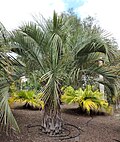| Image | Scientific name | Distribution |
|---|
 | Butia archeri (Glassman) Glassman | Goiás, Brasília, Minas Gerais, São Paulo |
| Butia arenicola (Barb.Rodr.) Burret | Mato Grosso do Sul, Paraguay |
| Butia campicola (Barb.Rodr.) Noblick | Mato Grosso do Sul, Paraguay |
 | Butia capitata (Mart.) Becc. | Minas Gerais, Goiás, Bahia |
| Butia catarinensis Noblick & Lorenzi | Rio Grande do Sul, Santa Catarina |
 | Butia eriospatha (Mart. ex Drude) Becc.– Woolly butia palm [7] | Paraná, Rio Grande do Sul, Santa Catarina |
| Butia exilata Deble & Marchiori | Rio Grande do Sul |
| Butia exospadix Noblick | Mato Grosso do Sul, Paraguay |
 | Butia lallemantii Deble & Marchiori | Rio Grande do Sul, Uruguay |
| Butia lepidotispatha Noblick | Mato Grosso do Sul, Paraguay |
| Butia leptospatha (Burret) Noblick | Mato Grosso do Sul, Paraguay |
| Butia marmorii Noblick | Alto Paraná in Paraguay |
| Butia matogrossensis Noblick & Lorenzi | Mato Grosso do Sul |
| Butia microspadix Burret | Paraná, São Paulo |
 | Butia odorata (Barb.Rodr.) Noblick– South American jelly palm, [1] jelly palm, [1] [7] pindo palm [1] | Rio Grande do Sul, Uruguay |
 | Butia paraguayensis (Barb.Rodr.) L.H.Bailey– Dwarf yatay palm [7] | Brazil, Argentina, Paraguay, Uruguay |
| Butia pubispatha Noblick & Lorenzi | Paraná |
| Butia purpurascens Glassman | Goiás, Minas Gerais |
| Butia witeckii K.Soares & S. Longhi | Rio Grande do Sul |
 | Butia yatay (Mart.) Becc.– Jelly palm, [1] [7] yatay palm [1] [7] | Rio Grande do Sul, Uruguay, Argentina |
|








